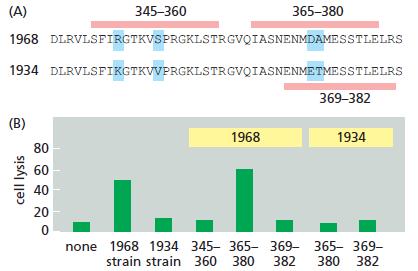For many years it was a complete mystery how cytotoxic T cells could see a viral protein
Question:
For many years it was a complete mystery how cytotoxic T cells could see a viral protein that seemed to be present only in the nucleus of the virus-infected cell. The answer was revealed in a classic paper that took advantage of a clone of T cells whose T cell receptor was directed against an antigen assoicated with the nuclear protein of the 1968 strain of influenza virus. The authors of the paper found that when they incubated high concentrations of certain peptides derived from the viral nuclear protein, the cells became sensitive to lysis by subsequent incubation with the cytotoxic T cells. Using various peptides from the 1968 strain and the 1934 strain (with which the cytotoxic T cells did not react), the authors defined the particular peptide responsible for the T cell response (Figure Q24–1).
A. Which part of the viral protein gives rise to the peptide that is recognized by the clone of cytotoxic T cells? Why do not all viral peptides sensitize the target cells for lysis by the cytotoxic T cells?
B. It is thought the MHC molecules come to the cell surface with peptides already bound. If that is so, how do you imagine that these experiments worked?
Figure Q24-1

Step by Step Answer:

Molecular Biology Of The Cell
ISBN: 9780815344322
6th Edition
Authors: Bruce Alberts, Alexander D. Johnson, Julian Lewis, David Morgan, Martin Raff, Keith Roberts, Peter Walter




